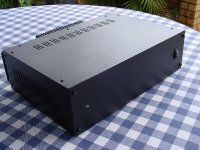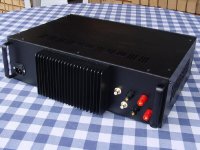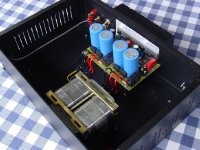Brian, Mark, and Russ -
Thanks for your emergency interventions. It is now up and running as prescribed.
I was pretty sure I understood after the diagrams - but the suggestion to check secondary voltages with a multimeter first made me feel more confident before hooking it all up. I am sure that is just good practice anyway.
Oddly, I notice very little difference in how the amp operates now versus the incorrect wiring. That's not a bad thing- it sounded great before too.
I still get the moderate level hum if the inputs are not attached to the pre-amp (they are isolated from the chassis- bolted into wood). I will try the suggested fixes for shielding the input wires first-- but as it sounds excellent under normal conditions I am not in a great hurry.
Thanks again,
George
Thanks for your emergency interventions. It is now up and running as prescribed.
I was pretty sure I understood after the diagrams - but the suggestion to check secondary voltages with a multimeter first made me feel more confident before hooking it all up. I am sure that is just good practice anyway.
Oddly, I notice very little difference in how the amp operates now versus the incorrect wiring. That's not a bad thing- it sounded great before too.
I still get the moderate level hum if the inputs are not attached to the pre-amp (they are isolated from the chassis- bolted into wood). I will try the suggested fixes for shielding the input wires first-- but as it sounds excellent under normal conditions I am not in a great hurry.
Thanks again,
George
Good job...
Check the tension with the multimeter is a must, you have do to it every time you are going to connect a trafo to your audio equipment. My amp, with the pwr_gnd connected to the case as I said, is dead quite, even with 105dB horn tweeter.
Mauro did a great job with multiple gnd...
Mark
Check the tension with the multimeter is a must, you have do to it every time you are going to connect a trafo to your audio equipment. My amp, with the pwr_gnd connected to the case as I said, is dead quite, even with 105dB horn tweeter.
Mauro did a great job with multiple gnd...
Mark
Trasformer
Please help me because last posts put me in confusion.
How I have to connect the secondary of trasformer?
+24V (fist secondary) ----------------------------------> AC1
0V(first secondary) & + 24V (second secondary) -> PGND
0V (second secondary) --------------------------------> AC2
Is this correct?
Thank you.
Andrea
Please help me because last posts put me in confusion.
How I have to connect the secondary of trasformer?
+24V (fist secondary) ----------------------------------> AC1
0V(first secondary) & + 24V (second secondary) -> PGND
0V (second secondary) --------------------------------> AC2
Is this correct?
Thank you.
Andrea
If your transformer has 3 wires on the secondary side, then the 0v wire goes to the center tab on the rev_c. and then match one voltage wire to each tab. 3 wires, 3 tabs.
If your transformer has 4 wires on the secondary they are grouped in 2 pairs (2 pairs = 4 wires)
Take one wire from each pair and connect to the center tab on the Rev_c.
Take one of the remaining wires and connect it to the right tab, and one to the left. 4 wires, 3 tabs. 2 wires to the center tab.
Done.
Note:
Some people say to keep the secondaries "in phase" while NAIM (FAMOUS for theire pwr supplies) says flip the phases.
It is a matter of preference.
If your transformer has 4 wires on the secondary they are grouped in 2 pairs (2 pairs = 4 wires)
Take one wire from each pair and connect to the center tab on the Rev_c.
Take one of the remaining wires and connect it to the right tab, and one to the left. 4 wires, 3 tabs. 2 wires to the center tab.
Done.
Note:
Some people say to keep the secondaries "in phase" while NAIM (FAMOUS for theire pwr supplies) says flip the phases.
It is a matter of preference.
jeppix,
Your secondary windings connections description sounds ok, except that the end that connects to AC2 will now be at -24V.
The end of the top secondary winding in your Transformer manufacturer's connection diagram, that you joined to the start of the lower sec. winding, now becomes the centre tap which is at 0V. This connection goes to PGND on each board.
This connection is called a series connection. It just means that the end of one winding is connected to the beginning of the other winding.
Audie.
Your secondary windings connections description sounds ok, except that the end that connects to AC2 will now be at -24V.
The end of the top secondary winding in your Transformer manufacturer's connection diagram, that you joined to the start of the lower sec. winding, now becomes the centre tap which is at 0V. This connection goes to PGND on each board.
This connection is called a series connection. It just means that the end of one winding is connected to the beginning of the other winding.
Audie.
Clipping
Has anyone also experienced that this amp clips much easier as say a GC on less efficient speakers it can be very annoying.
i have build several and all of them does it. on my system i have to play very load before it happens but on a Dahlquist system it is just terrible.
any solution? (and dumping the Dahlquist is not a option)
Has anyone also experienced that this amp clips much easier as say a GC on less efficient speakers it can be very annoying.
i have build several and all of them does it. on my system i have to play very load before it happens but on a Dahlquist system it is just terrible.
any solution? (and dumping the Dahlquist is not a option)
There is no way to make any amplifier perform past its specifications without loss of audio quality, clipping in your case Rudi. You would have to parallel devices for the current pump (which I have experimented with with sucess) to drive extremely difficult loads. It is not so hard to do, give it a try.
Remeber this is not a simple one device voltage amp like a GC, so the amp "sees" the load a little differently.
To be honest though I have no trouble driving most 4 ohm loads, as long as the speaker is not terribly inefficient (>85db) with my monoblocks.
I do have some 4ohm speakers (<80db) that simply are not a good match for this amp, and they don't sound good really with anything less than 100W, but I would not call those my best speakers.
Cheers!
Russ
Remeber this is not a simple one device voltage amp like a GC, so the amp "sees" the load a little differently.
To be honest though I have no trouble driving most 4 ohm loads, as long as the speaker is not terribly inefficient (>85db) with my monoblocks.
I do have some 4ohm speakers (<80db) that simply are not a good match for this amp, and they don't sound good really with anything less than 100W, but I would not call those my best speakers.
Cheers!
Russ
Wiki page setup for MyRev
I read the post on setting up a wiki page as a repository for the MyRev information. I agree this would be a great idea. As soon as the DNS propigates I'll have one setup on http://MyRev.smithbox.com.
Lets move all the data/information relating to MyRev that we'd like to.
(In particular I'd like to see the schematics).
Thanks,
Jonathan Smith
I read the post on setting up a wiki page as a repository for the MyRev information. I agree this would be a great idea. As soon as the DNS propigates I'll have one setup on http://MyRev.smithbox.com.
Lets move all the data/information relating to MyRev that we'd like to.
(In particular I'd like to see the schematics).
Thanks,
Jonathan Smith
Padding Down Preamp Output
I am using an Audire Legato preamp and its output is so great that I can use less than a quarter of the volume control.
What is the best way to decrease the output of the preamp or the sensitivity of the amp 10-20 Db so that I have more control.
I would guess resistors on the preamp outputs would do it, but am not sure of the values. Can this be done with no negative effects on the sound?
I thought I remembered seeing something like this being asked before but could not find it. Thanks in advance.
George
I am using an Audire Legato preamp and its output is so great that I can use less than a quarter of the volume control.
What is the best way to decrease the output of the preamp or the sensitivity of the amp 10-20 Db so that I have more control.
I would guess resistors on the preamp outputs would do it, but am not sure of the values. Can this be done with no negative effects on the sound?
I thought I remembered seeing something like this being asked before but could not find it. Thanks in advance.
George
Re: Wiki page setup for MyRev
DNS succeeds from where I am:
Name: myrev.smithbox.com
Address: 67.18.11.2
But there is no page there:
Isn't there a wiki here on DIYAudio? Why wouldn't we set it up here? No offence, but personal websites come and go... People move ISP's, lose jobs, change careers etc and all of a sudden things stop working
Michael
Udance said:I read the post on setting up a wiki page as a repository for the MyRev information. I agree this would be a great idea. As soon as the DNS propigates I'll have one setup on http://MyRev.smithbox.com.
Lets move all the data/information relating to MyRev that we'd like to.
(In particular I'd like to see the schematics).
Thanks,
Jonathan Smith
DNS succeeds from where I am:
Name: myrev.smithbox.com
Address: 67.18.11.2
But there is no page there:
Not Found
The requested URL / was not found on this server.
Additionally, a 404 Not Found error was encountered while trying to use an ErrorDocument to handle the request.
Isn't there a wiki here on DIYAudio? Why wouldn't we set it up here? No offence, but personal websites come and go... People move ISP's, lose jobs, change careers etc and all of a sudden things stop working
Michael
Re: Re: Wiki page setup for MyRev
All working now..
Non taken. And this site has been stable for at least 9 years.. will continue to be so for another 30 at least. I think it gives us the options of doing what we want. I've currently put up phpwiki, but we can use most anything else that suites the neeeds if we need it.
will continue to be so for another 30 at least. I think it gives us the options of doing what we want. I've currently put up phpwiki, but we can use most anything else that suites the neeeds if we need it.
Plus we can easily expand it into other threads or areas of discussion.. I mostly set it up as an opportunity to help get some of this information put together in one spot.
However it ends up.
Jonathan
maf_au said:
DNS succeeds from where I am:
Name: myrev.smithbox.com
Address: 67.18.11.2
But there is no page there:
Isn't there a wiki here on DIYAudio? Why wouldn't we set it up here? No offence, but personal websites come and go... People move ISP's, lose jobs, change careers etc and all of a sudden things stop working
Michael
All working now..
Non taken. And this site has been stable for at least 9 years..
Plus we can easily expand it into other threads or areas of discussion.. I mostly set it up as an opportunity to help get some of this information put together in one spot.
However it ends up.
Jonathan
rudi said:thanks Russ
do you have a diagram for me please.
I would love to try. how did the parallel's sound quality compare to the singel device.
Cheers
Rudi
Hi Rudi,
Busy Thankgiving weekend here. First, I am not done with the schematic nor the experiment so I will not post details yet. But genarlly I will hint that pretty much the LM3886s are stacked, and current in the NFB loop is adusted accordingly. It does require some changes to the resistor values.
The version I have is very finicky, it is not stable under all conditions, and I am working with Mauro to try to figure it out, so I will not subject the thread to it yet.
Right now I would say the sound is not as good as my normal monoblocs, but I did not expect it to be since it is not finished.
In the end though, I doubt I would persue a part like the LM3886 for very high power. I would be more inclined to try the LM4702 and good output devices like SAP16s.
Cheers!
Russ
Some pics of my new amp
Here is some pics of my newly completed amp.
The transformer is a 550VA C-core one with 4x 28Vac outputs. There is space for a second one, for future upgrades.
The blue caps are Sprague 10000uF caps.
The sound is AWESOME! The bass is clean and precise while not drowning out any detail.
Great design Mauro! Thanks Rudi for all the help with this amp project. Appreciate it!
(Pic 1 of 3)
Here is some pics of my newly completed amp.
The transformer is a 550VA C-core one with 4x 28Vac outputs. There is space for a second one, for future upgrades.
The blue caps are Sprague 10000uF caps.
The sound is AWESOME! The bass is clean and precise while not drowning out any detail.
Great design Mauro! Thanks Rudi for all the help with this amp project. Appreciate it!
(Pic 1 of 3)
Attachments
PSmithMX-
Really beautifully done work. It looks like you have done these before. What kind of case is that? I like the layout.
I agree with you on the sound. I was most impressed by the combination of excellent detail with a total lack of solid state sheen. Everything sounds coherent and musical.
I have put my $1400 tube amp up for auction- this sounds better, at least in my set up.
Really beautifully done work. It looks like you have done these before. What kind of case is that? I like the layout.
I agree with you on the sound. I was most impressed by the combination of excellent detail with a total lack of solid state sheen. Everything sounds coherent and musical.
I have put my $1400 tube amp up for auction- this sounds better, at least in my set up.
Killed my RevC
Stupid me ... Last night I wanted to measure TSPs of some woofers, didnt notice that I accidentdly shorted my RevC´s outputs.
Last night I wanted to measure TSPs of some woofers, didnt notice that I accidentdly shorted my RevC´s outputs.  So I wondered why there was no sound, and now my beloved gem is dead. When powering it up, the relays don´t ´switch. Nothing inside looks fried. Any idea what could be faulty ? Help me, please
So I wondered why there was no sound, and now my beloved gem is dead. When powering it up, the relays don´t ´switch. Nothing inside looks fried. Any idea what could be faulty ? Help me, please 
Stupid me ...
 Last night I wanted to measure TSPs of some woofers, didnt notice that I accidentdly shorted my RevC´s outputs.
Last night I wanted to measure TSPs of some woofers, didnt notice that I accidentdly shorted my RevC´s outputs.  So I wondered why there was no sound, and now my beloved gem is dead. When powering it up, the relays don´t ´switch. Nothing inside looks fried. Any idea what could be faulty ? Help me, please
So I wondered why there was no sound, and now my beloved gem is dead. When powering it up, the relays don´t ´switch. Nothing inside looks fried. Any idea what could be faulty ? Help me, please 
- Home
- Amplifiers
- Chip Amps
- My "audiophile" LM3886 approach


